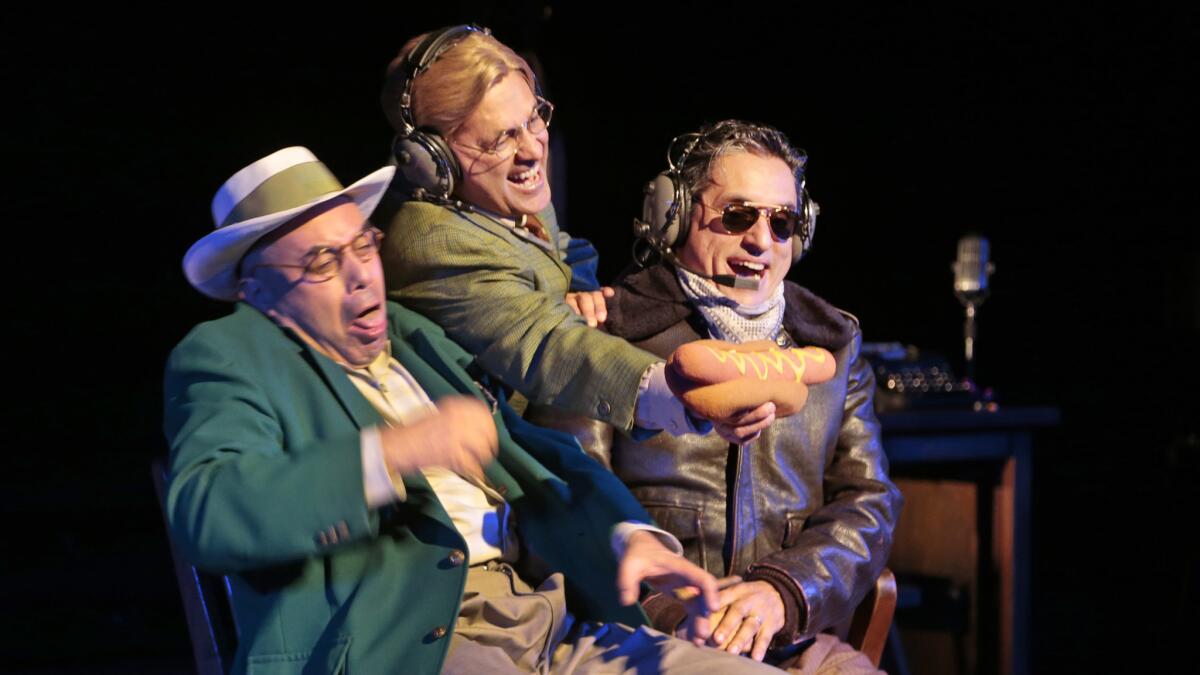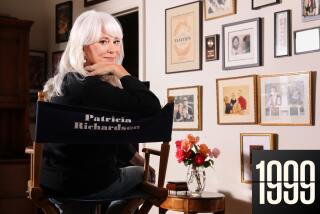Review: ‘Chavez Ravine: An L.A. Revival’ misplays the drama

It’s hard to imagine Culture Clash’s “Chavez Ravine: An L.A. Revival” receiving a more handsome production than the one directed by Lisa Peterson at the Kirk Douglas Theatre, a retooled version of her 2003 staging of “Chavez Ravine” at the Mark Taper Forum.
But a play can’t be manufactured from the stylish arrangement of scenic elements, and there’s a nagging sense throughout of a dramatic deficiency being covered over. For a long time, however, Peterson’s ace design team made me want to believe.
A rectangular screen hovering just above the action shows us vintage images of Los Angeles from the time when the area that is now the home of Dodger Stadium was a rural hillside village inhabited mostly by Mexican American families. Other screens situated on the sides of the house plunge audiences more deeply into the visual history of a community that resembles from a distance Topanga Canyon but is in fact adjacent to downtown Los Angeles. (Hard to believe without the usual snarl of traffic.)
The stage is arrayed as a radio studio, with an onstage trio playing Mexican folk music and popular American songs. Standing microphones are planted throughout Rachel Hauck’s alluring set, with its wooden floor and desks giving off a sturdy antique vibe.
José López’s lighting supplies a fitting sepia glow. Paul James Prendergast’s sound design finds just the right radio crackle. But it’s Jason H. Thompson’s canny projection design that most vividly conjures Los Angeles in the 1950s, when a battle was unfolding between residents of Chavez Ravine and those municipal and business interests determined to evict them.
The play, written and performed by Culture Clash’s Richard Montoya, Ric Salinas and Herbert Siguenza, tells the story of a neighborhood bulldozed in the name of gentrification. Quite a bit of history — too much perhaps — is recapped, from the promise of public housing that was ultimately quashed by malicious red-baiting to the luring of the Dodgers from Brooklyn to the final erasure of a neighborhood that was called a shantytown by those who didn’t live there and home by those who did.
It’s a somber tale that proceeds in earnest (clichéd earnestness, to tell the truth) when the story focuses on Maria Ruiz (played by Sabina Zuniga Varela), a young Chavez Ravine resident who tries to organize her community to stop the eviction.
But for the most part the story is refracted through the zany Chicano vaudeville style that is Culture Clash’s signature.
The play begins in 1981 at Dodger Stadium, where Fernando Valenzuela is pitching the season opener. He is interrupted by Maria and her brother Henry, who urge him to connect to the Latino history beneath his feet, where mothers would bury their babies’ umbilical cords in keeping with the Mexican custom.
The piece then harks back to how the Chavez Ravine neighborhood was lost. The personal story of Maria’s family is set in the larger context of urban planning and politics in Los Angeles — subjects ripe for Culture Clash-style satire but also deserving of serious public review.
Montoya, Salinas and Siguenza are great kidders. They love sending up politicians, such as former congressman and Los Angeles Mayor Norris Poulson, who is farcically portrayed as a puppet of business interests. Dodgers owner Walter O’Malley is caricatured as an oblivious fat cat. And a “cub reporter” investigating the “Chavez Ravine” tussle comes off as a self-interested twit.
Not even Frank Wilkinson, the City Housing Authority manager who was smeared as a communist during his attempt to push through a public housing project in Chavez Ravine, emerges unscathed. (Though he’s given his due at the end.)
The jokiness is relentless and of variable quality. Some of the ethnic lampooning — all groups are fair game — seems puerile. And the silliness makes it difficult to find one’s historical footing or to assign value to points of view.
Peterson does a remarkable job of finding a tone for the production to contain all this horseplay, no easy task when groaners can matter more than character development.
The band (Vaneza Mari Calderón, Randy Rodarte and Scott Rodarte) helps to create this accommodating groove.
But was there a dramaturgical reason to reenact Abbott and Costello’s “Who’s On First?” routine? Sure it’s enjoyably performed and put forth in the same baseball spirit of the “Take Me Out to the Ball Game” sing-along, in which hats and loose popcorn are thrown into the audience. But Culture Clash’s anxiety about keeping us entertained at every second gets in the way of its playwriting.
The staging is of such high caliber and the material has so much import that it would have been nice to see these artists put more faith in the sophistication of their audience — and their own ability as storytellers.
Black-and-white film footage of a family being removed from their home is shown at the end. It’s a reminder that as ludicrous as politics can be, the consequences are no laughing matter.
Twitter: @charlesmcnulty
More to Read
The biggest entertainment stories
Get our big stories about Hollywood, film, television, music, arts, culture and more right in your inbox as soon as they publish.
You may occasionally receive promotional content from the Los Angeles Times.











